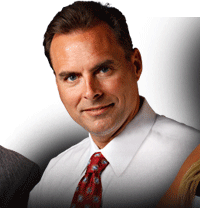Armed with zero interest rate policy and the most aggressive monetary campaign in history, investors elevated the financial markets to heights only rarely seen in human history. Yet, despite record valuations, pandemics, warnings, and inflationary pressures, the “animal spirit” fostered by an undeniable “faith in the Federal Reserve” remain alive and well.
Of course, the rise in “animal spirits” is simply the reflection of the rising delusion of investors who frantically cling to data points that somehow support the notion “this time is different.” As David Einhorn once stated:
Fisher does “mental gymnastics” to suggest the sell-off in 2018 was due to forces other than the Fed. However, what reversed the “bullish psychology” was evident.
“The really extremely accommodative low-interest rates that we needed when the economy was quite weak, we don’t need those anymore. They’re not appropriate anymore. Interest rates are still accommodative, but we’re gradually moving to a place where they will be neutral. We may go past neutral, but we’re a long way from neutral at this point, probably.” – Jerome Powell, Oct 3rd, 2018
That sharp sell-off in the chart above started following that statement from Jerome Powell. Why? Because even though the Fed had already started hiking rates previously, the comment suggested much tighter policy to come.
What reversed that “bear market psychology” just two months later? The Fed’s reversal on their “neutral stance.”
“Where we are right now is the lower end of neutral. There are implications for that. Monetary policymaking is a forward-looking exercise, and I’m just going to stick with that. There’s real uncertainty about the pace and the destination of further rate increases, and we’re going to be letting incoming data inform our thinking about the appropriate path.” – Jerome Powell, Dec 18th, 2019
By the summer of 2019, the Fed’s interest rates returned to ZERO.
Why did the market rally?
“Don’t fight the Fed.”
Never Fight The Fed
“Rate hikes aren’t inherently bearish, in our view. Like every monetary policy decision, whether they are a net benefit or detriment depends on market and economic conditions at the time, including how they affect the risk of a deep, prolonged, global yield curve inversion. 2018’s rate hikes flattened the yield curve, but they didn’t invert it.” – Fisher Investments
They are. It is just a function of timing between the first rate hike and when something eventually breaks the “bullish psychology.” As we discussed previously:
“In the short term, the economy and the markets (due to the current momentum) can DEFY the laws of financial gravity as interest rates rise. However, as interest rates increase, they act as a “brake” on economic activity. Such is because higher rates NEGATIVELY impact a highly levered economy:”
Fisher is correct that rates may not impact the financial markets in the short term. However, most of the gains got forfeited in every instance as interest rates slowed economic growth, reduced earnings, or created some crisis.
Most importantly, a much higher degree of reversion occurs when the Fed tightens monetary policy during elevated valuations. For example, beginning in 1960, with valuations over 20x earnings, the Fed started a long-term rate-hiking campaign that resulted in three bear markets, two recessions, and a debt crisis. The following three times when the Fed hiked rates with valuations above 20x, outcomes ranged from bear markets to some credit crisis needing bailouts.
Yes, rate hikes matter, and they matter more when there are elevated valuations.
“I Fought The Fed, And The Fed Won“
The primary bullish argument for owning stocks over the last decade is that low-interest rates support high valuations.
The assumption is the present value of future cash flows from equities rises, and subsequently, so should their valuation. Assuming all else is equal, a falling discount rate does suggest a higher valuation. However, as Cliff Asness noted previously, that argument has little validity.
“Instead of regarding stocks as a fixed-rate bond with known nominal coupons, one must think of stocks as a floating-rate bond whose coupons will float with nominal earnings growth. In this analogy, the stock market’s P/E is like the price of a floating-rate bond. In most cases, despite moves in interest rates, the price of a floating-rate bond changes little, and likewise the rational P/E for the stock market moves little.” – Cliff Asness
The problem for the bulls is simple:
“You can’t have it both ways.”
Either low-interest rates are bullish, or high rates are bullish. Unfortunately, they can’t be both.
As noted, rising interest rates correlate to rising equity prices due to market participants’ “risk-on” psychology. However, that correlation cuts both ways. When rising rates reduce earnings, economic growth, and investor sentiment, the “risk-off” trade (bonds) is where money flows.
With exceptionally high market valuations, the market can remain correlated to rising rates for a while longer. However, at some point, rates will matter.
This time will not be different. Only the catalyst, magnitude, and duration will be.
Investors would do well to remember the words of the then-chairman of the Securities and Exchange Commission Arthur Levitt in a 1998 speech entitled “The Numbers Game:”
“While the temptations are great, and the pressures strong, illusions in numbers are only that—ephemeral, and ultimately self-destructive.”
You can fight the Fed, but eventually, the Fed will win.

Finally, investing that makes sense. Lance Roberts has a unique ability to bring the complex world of politics, economics, investing and personal financial wealth building to you in simple, easy and informative way. Rather than just regurgitating the news of the day, Lance looks at the “raw data” to bring a unique and “unspun” perspective to the conversation. Lance deep understanding of fundamental, technical and economic perspectives, combined with his unique focus, helps listeners, readers and investors understand how it impacts their family, their money and their life.
Having been in the investing world for more than 25 years, from private banking and investment management to private and venture capital, Lance has pretty much "been there and done that" at one point or another. His common sense approach, clear explanations and “real world” experience has appealed to audiences for almost two decades.
After building an extremely successful Registered Investment Advisory firm in Houston, Texas with almost $700 million in AUM, Lance is back at it building the next generation wealth advisory firm incorporating new tech with old money.
Lance is the Chief Editor of the Real Investment Report, a weekly subscriber based-newsletter that is distributed globally. He is also writes a daily blog which is read by tens of thousands from individuals to professionals, and his opinions are frequently sought after by major media sources.
Lance’s investment strategies and knowledge have been featured on CNBC, Fox Business News, Business News Network and Fox News. He has been quoted by a litany of publications from the Wall Street Journal, Reuters, Bloomberg, The New York Times, The Washington Post all the way to TheStreet.com. His writings and research have also been featured on several of the nation's biggest financial blog sites such as the Pragmatic Capitalist, Credit Writedowns, The Daily Beast, Zero Hedge and Seeking Alpha.
realinvestmentadvice.com




